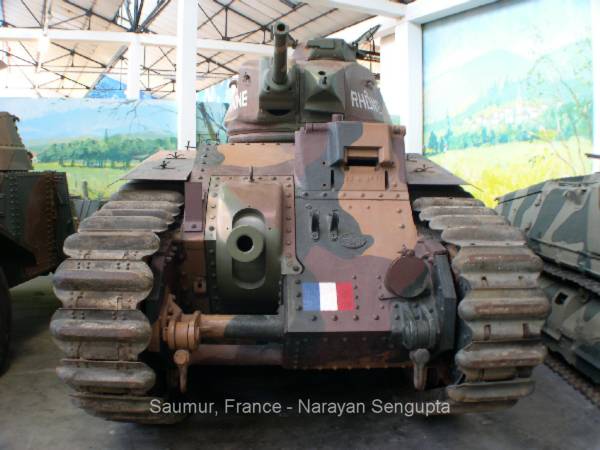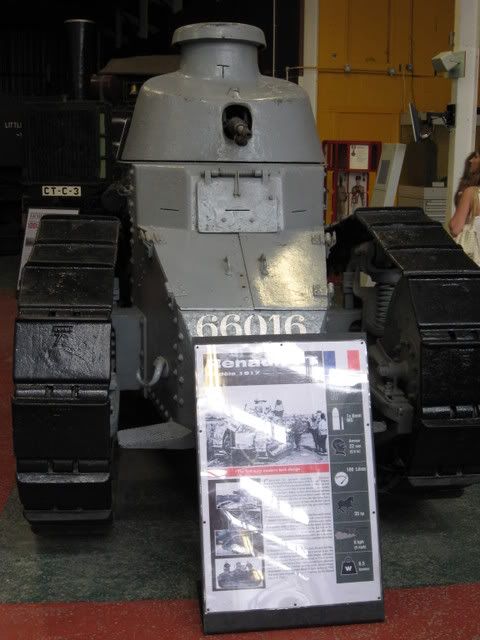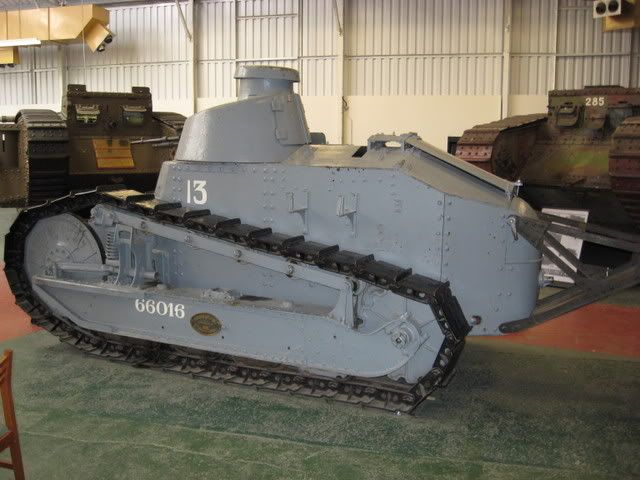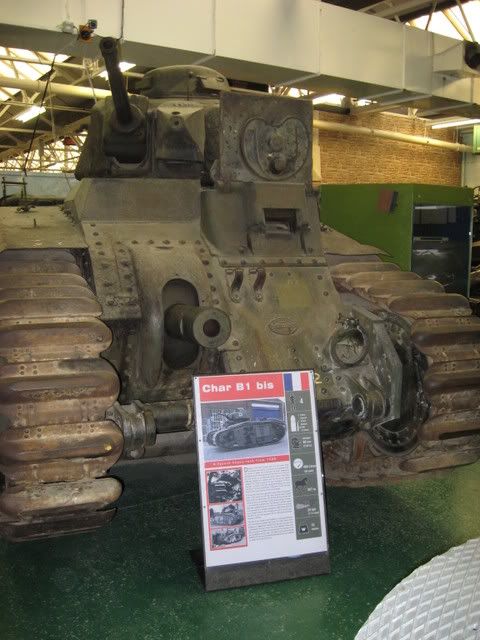A topic for the all the armored vehicles used since 1918.


A topic for the all the armored vehicles used since 1918.

Char D’Assault St. Chamond
The tanks saw their first action on September 15, 1916, when the British Commander-in-Chief in France,Marshal Haig, ordered the first two tank companies to be employed against the German forces during the Battle of the Somme.
Albeit the modest results of this action, due to lack of trained crews, mechanical damages and inexperience in tank field employement , the new weapon had, however, a highly remarkable psychological impact.
At the same time the French were developing their own tanks
(a little anecdote : the French attributed to J.L.Breton, a French engineer, the invention of the new armored weapon; a special French-British committee was later appointed to decide about tank’s actual paternity.).
Forgetting these chauvinistic disputes, nobody can deny that French tanks’ “Father” was Col. Estienne. In spite of the military authorities’ indifference and skepticism about the new weapon, he obtained Gen. Joffre’s (French Army Commander-in-Chief) support and developed two types of tanks, both following the “assault gun” concept.

Figuring in as the forerunner to the modern day self-propelled gun, the St. Chamond was of a French design and saw combat through most of World War 1. The system was plodding and heavy, never really able to traverse typical battlefield terrain, but nevertheless could field a powerful main gun in the form of the 1897 75mm model.
Requiring a crew of nine personnel to man and operate the machine, the St. Chamond was the brainchild design of one Colonel Rimailho. Classified as a “tank” these systems were actually more designed in the form of what we would term an “assault gun”, or a predecessor to the modern day self-propelled versions so common after World War Two. The 75mm served as the primary armament to the St. Chamond and an additional 4 x Hotchkiss 8mm (.315 inch) machine guns were used as secondary defensive weapons.

The St. Chamond was designed and engineered long and low, another detriment to the already crippled design as the system would have a hard go at it when managing anything more than level terrain - often becoming stuck where today’s battle tanks could easily tread. Additionally, the short tread length coupled with the long hull design made the system difficult to handle. The heavy electric transmission that operated with the gasoline engine added considerable weight. As such, the system, though enjoying some usefulness throughout the war, was eventually relegated to supplementary roles by war’s end - though it would serve throughout the war’s entirety. By then, more effective battlefield systems were being fielded by all sides, making the St. Chamond design a vintage attempt. Most would end up as supply carriers as a result of these glaring deficiencies.

The problems with the St. Chamond were like those of many early tanks, as they were based on mounting an armored “box” on top of the new commercial catarpillar tractors (such as the “Holt”)which had come to market. though a good concept, the small tracks, and high center of gravity made these vehicles top heavy, and cumbersome as the superstructures frequently hung well over the ends of the tracks. The weight of the superstructures, and fittings often burdened the tractors to the point of causing frequent mechanical failures. These problems were somewhat rectified with the advent of the better thought out rhomboidal tanks having the tracks return along the upper part of the hull, lowering the center of gravity, (but not the meantime between failures)
I have a few pictures of french tanks from my trip to Bovington.I’ll post them when I’ll be back home.
As promised:


Renault FT17 from Bovington


Heres a site with a fairly complete roster of French tanks. Incl;uding some never built.
http://www.chars-francais.net/new/index.php?option=com_content&task=view&id=1202&Itemid=99
The problems with the St. Chamond were like those of many early tanks, as they were based on mounting an armored “box” on top of the new commercial catarpillar tractors (such as the “Holt”)which had come to market. though a good concept, the small tracks, and high center of gravity made these vehicles top heavy, and cumbersome as the superstructures frequently hung well over the ends of the tracks. The weight of the superstructures, and fittings often burdened the tractors to the point of causing frequent mechanical failures. These problems were somewhat rectified with the advent of the better thought out rhomboidal tanks having the tracks return along the upper part of the hull, lowering the center of gravity, (but not the meantime between failures)
Completely agreed, but you got to start with something :mrgreen: and the St chamond was better armed than the british mark I to IV. I guess it also had a “nose heavy” problem due the gun.

I have a few pictures of french tanks from my trip to Bovington.I’ll post them when I’ll be back home.
As promised:
Nice pictures the Somua is an atractive vehicle.
Heres a site with a fairly complete roster of French tanks. Incl;uding some never built.
Thank you.
The tank I was referring too in another thread was called the ARL44:
The design of this tank started clandestinely when France was still under German occupation. After the Normandy landings, the French restarted their war industry. Production was carried out by both FAMH and Renault under the parentage of the ARL. Christened ‘Char de Transition ARL-44’, the ARL 44 was based largely on the pre-war Char B1 bis. The first unit became ready only after the war had ended in 1946. The new French heavy tank came equipped with a 90mm cannon housed in a Schneider turret powered by a Simca traversing gear. The ARL 44 used the same tracks as the Char B1 bis, but were protected by skirting plates. Only 60 units were ever produced. This tank made its one and only public appearance at the National Day Parade on 14 July 1951.

[ul]Specifications Weight 45 tons
Crew 5
Length 35.5’
Width 11.6’
Height 10.5’
Engine Maybach, gasoline
Performance 23.1 mph
Armament 90mm, 2 x MG[/ul]

Interesting tank, at first glance it looks like a bad mixture of Panther frontal armor, French B1 tracks and a Pershing gun turret.
Nice, nice, some specifications of this AFV. It say “Maybach gasoline” , it is probably a Panther engine, other ingredient to this frankestein. sadly no armor data.

Char 2C, the monster.

The development of this massive tank began in 1917 with the foresight of the famous “1919 plan”, an allied program aimed to finally break the german lines in that year using a large scale attack spearheaded by heavy tanks and armored aeroplanes. It was the heaviest tank ever made until the upcoming of the Tiger II in late 1943 .




Aditional information about the 2C.

The NC medium.
This armored vehicle was designed in mid 1920s as infantry support medium tank,it introduced the intrincated coil spring suspension, used later by all Renault tanks. Some went to China and Japan.


Well, but all these tanks didn’t help them in 1940…
You could say that the French army was the army best equipped to fight another WW1 - but not for the new kind of war.
They pretty much worked on improving their tank and war machinery in exactly the wrong ways…
This used to be at APG.
It is in France now.
My buddy is in Tennessee.

:lol: Nice pic Forager.
Well, but all these tanks didn’t help them in 1940…
You could say that the French army was the army best equipped to fight another WW1 - but not for the new kind of war.
Well the had the factories,they had the steel and they had the guns, but they dont really know how blend all that in a workable, all around tank.
The German govt post treaty had sent many professional people to other countries working for subsidiaries of German Companies. While there, they were to secretly design, and refine drawings of the types of aircraft and weapons that may be needed in the future, as Hitler was already preparing for the re-militarization of Germany.All of these efforts contributed to the re-arming of Germany by eliminating the long period of development of these weapons, and equipments. That being done mostly on paper during the hide out years. When the “New” Germany was ready to begin arming, the plans, and drawings were in hand, ready to produce the goods decided upon. Germany’s intended victims had not given much thought to the idea of Germany not playing by the rules, and so were not ready for these new machines, and tactics. By their trickery, they were ahead of the game, and everyone else had to play catch-up. Japan used those basic designs of aircraft to produce their planes, only adjusting the designs to fit their particulars.
The “flexibility of thinking” also helped the germans, they not designed several tanks for a single use, but several tanks wich could be developed and improved.
I can assure you that making a SOMUA was by far more complicated an expensive to manufacture a panzer III. however this late and somewhat simple tank proved to be a winner in the 1939-41 period, and the SOMUA a simple technical curiosity.
A Trend the French seem to continue with their movies to this day. I mean, seriously, have any of you seen one of these French ‘High Class’ movies recently?
I’m sure they were expensive to produce and they were very elaborate, but to put it mildly: They’re bullshit.
Cant tell, the last French Picture I saw was in 1996 :mrgreen: capitan Conan, a good one.
The Char B1:
This tank was France s main battle tank at the time of may 1940. It clearly exemplify the virtues and vices of all french armor in ww2, an excellent, innovative design with several technical values, delicatedly manufactured, powerful weapons and heavy armor, however the bad crew layout and duties made it a nightmare of command and control in the battlefield.




